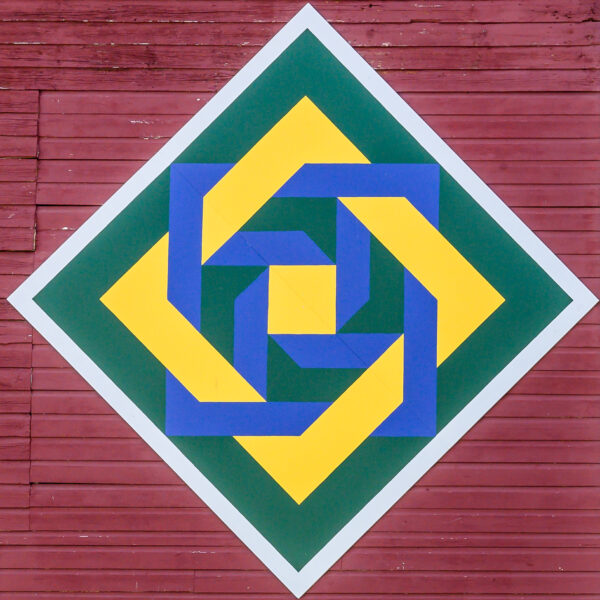Block Name: “The Power of Water”
Host Name: Needlers Mill
Address: 1 Needlers Lane, Millbrook

“The Power of Water”
The barn quilt block at Needler’s Mill is purposefully mounted on the edge of the west wall to connect, as closely as possible, the mill to the millpond. It is the abundance and the power of water that attracted settlers to this valley where Baxter Creek and many tributaries offer opportunities to harness this natural source of energy. The traditional quilt pattern used, called Slipknot, evokes motion and the turning of a water wheel or turbine to produce the power that ran the machinery in the mill. The colours chosen tell the story: blue represents the water; yellow recalls the golden wheat that was harvested and delivered to the mill to be ground into fine white flour; green suggests the surrounding forests that supplied logs for the sawmill that produced lumber for the construction of local homes and barns.
The first mill, Deyell’s, was established on this site early in the 1820s. Financed by John Deyell and operated by the landowner James Deyell, the mill prospered, processing flour and cattle feed until 1857 when it burned to the ground. The property was then purchased by the Needler family, owner/operators of the Cedar Valley Mill several kilometers downstream. An impressive three-storey flour and grist mill was erected on the site of Deyell’s Mill, with a water wheel on the east side powering the machinery. Like its predecessor, Needler’s Mill was of wood frame construction and, in 1909, fire reduced it to a smoldering heap of twisted machinery and charred timbers. A portion of the Cedar Valley mill was moved to Millbrook to replace it, and production resumed, powered now by a turbine housed in a machine shed attached to the mill. In 1917, Henry C. Attwool bought the mill where he put in 8-hour days for nearly 50 years, proving to be an excellent miller, valued for his integrity and the quality of his work. He and his nephew and business partner Doug Sheppard produced fine white flour, cracked wheat and livestock feed, and milled lumber in the adjacent sawmill they built in 1922. The sawmill ceased operation in 1959 when Henry Attwool died, but Doug Sheppard continued the grist operation until the early 1970s.
The mill and surrounding land was bought by Otonabee Conservation in 1967, and was declared surplus to their needs in 2015. Threatened at the same time with an Unsafe Building Order issued by the Township, the derelict structure was purchased by the Millbrook and Cavan Historical Society and, with donations from hundreds of supporters, set on a new foundation and repaired. The sawmill, the machine shed housing the turbine, and the penstock that brought water from the millpond to generate power at the mill were all dismantled to fulfill conditions of sale so that Needler’s Mill could be preserved.
Block designed by Betty Hobson
Block painted by Maya deMaria
Barn Quilt Trail Etiquette:
Please Respect Private Property. Most quilt blocks are installed on private property and should be viewed from the road.
Please do not trespass. In some cases - only where clearly indicated - the barn quilt may be located on a business and the property may be open to the public.
Please drive carefully. Stopping along busy roads can be dangerous and illegal. Use caution when slowing or stopping near a site
